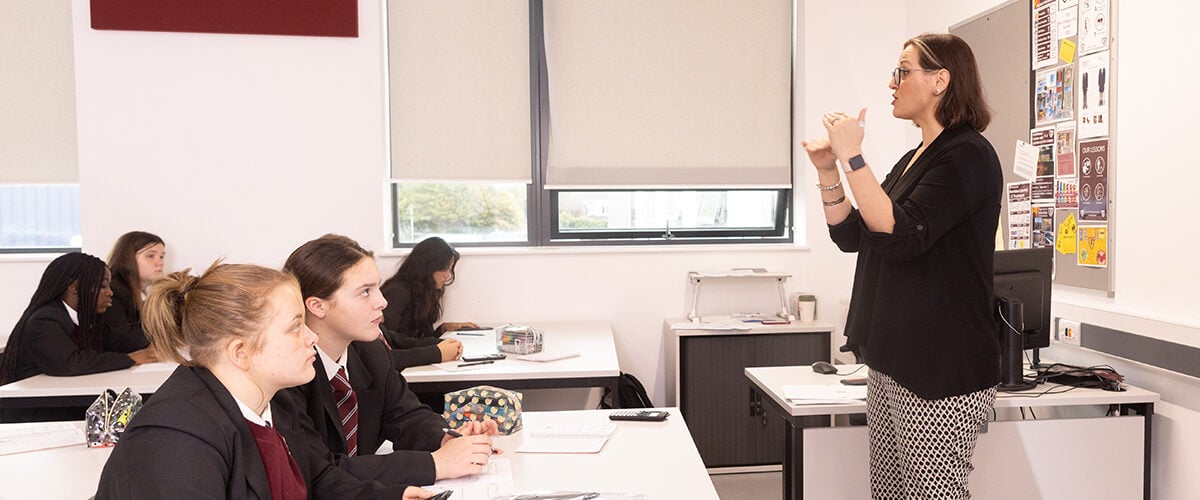Comparing Casio calculators, from entry level to advanced

All Casio calculators – from our ClassWiz scientific calculators to the most advanced graphing handsets – are highly capable devices that can support teachers and students at all stages of secondary education.
But there are some significant differences between our models. With that in mind, we wanted to take a closer look at some key features and distinctions across the current Casio calculator range, with insights from mathematician and training instructor, Simon May.
Laying the foundations: the fx-83/85GT CW
The fx-83GT CW and fx-85GT CW are our entry-level scientific calculators and are identical in functionality, the only difference being that the latter offers solar power.
They’re ideally suited to key stage 3 students who are establishing the foundations of their mathematical knowledge from years 7 to 9 and starting to prepare for their GCSEs.
When you start using these handsets with your students, you’ll find the following features pre-installed:
- Calculate: for general tasks and calculations such as square numbers, square roots, surds, fractions, percentages and decimals.
- Statistics: for statistical and regression calculations.
- Table: generates a number table from one or two input functions.
- Ratio: for ratio calculations.
- Math Box: offers functions including dice roll and coin toss probability simulations and number line graphs for up to three equalities or inequalities.
In terms of how these tools can be used in practice, Simon offered examples such as using Table mode to build understanding of how numbers behave under certain conditions.
After defining a function such as f(x) = x2 or f(x) = x2 + 3, using the new Tools key, a range of x-values can be entered to populate the table, which can be a good route into understanding square numbers and starting to explore functions.
Simon also commented on the overall benefits of using an entry-level scientific calculator such as the fx-83GT CW to introduce students to using this technology as early as possible in secondary school.
“The sooner they get hold of a calculator, the more effective a tool it will be for them, because they’ll quickly build familiarity with how to use it,” he said. “In responses to questions, they will be more comfortable with those default movements and asking where the calculator can help them out.”
Deepening understanding and solving: the fx-991CW
The fx-991CW is our most advanced scientific calculator. It offers some significant upgrades in functionality compared to the fx-83/85GT CW, the benefits of which really become clear when students start exploring topics in greater depth from GCSE onwards.
One of the most notable examples of this is Solver, which uses Newton’s method to find decimal solutions to equations. This can be a useful teaching tool and provide valuable support when students start to build on their fundamental understanding by solving problems.
Simon noted that having the ability to input and solve equations on their calculator helps students take an independent, investigative approach to their learning, rather than relying entirely on what the teacher tells them.
Those who struggle with some of the finer details of algebra and formulae can also take reassurance from using the calculator to check their work.
The fx-991CW also offers other upgrades in functionality over the fx-83/85GT CW that will be most useful for higher-level GCSE and A-level students, including numerical calculus, complex number calculations, vectors and matrices.
“It makes sense for students to go from using the fx-83/85GT CW and learning how to operate the handset and navigate the menus, to then making the decision in year 9 or 10 about whether they could get extra help from the more advanced functionality of the fx-991CW,” Simon said.
To learn more about our scientific calculators, their features and the differences between them, take a closer look at our recently updated ClassWiz range.
Visualising and exploring in greater depth: the fx-CG100
The equation-solving functionality available on the fx-991CW is taken a step further on the fx-CG100, the most advanced handset we offer.
One of the defining features of the fx-CG50 is SolveN, which uses numerical analysis to find all solutions to an equation and presents them as exact values – as a fraction of π, an improper fraction or a surd, for example.
This sets it apart from the fx-991CW’s Solver, which is a highly effective tool, but relies on an approximate figure to start from – which can be achieved in Table mode – and only presents a single solution as a decimal.
Perhaps the most important aspect that distinguishes the fx-CG100 from our scientific calculators is its graphing functionality, which lets you add an entirely new, visual dimension to your teaching, students’ learning and overall understanding.
Simon gave us several examples of how this can be applied in practice, including:
- Drawing key concepts like quadratic and simultaneous equations, but also going a step further and exploring things like hyperbolics and drawing circles.
- Graphing parametric equations, which is useful when students are faced with questions that require them to go beyond just the x and y variables.
- Using dynamic graphing to animate a function such as sin(ax) and change the value of a.
- Using Recursion mode to graph sequences and series or numerical iteration.
“Thefx-CG100 is a really powerful handset, and it’s perfectly applicable to GCSE as well as A-level,” Simon said. “Starting to use it at GCSE is a good idea for students who will be going on to A-level maths, which is when the functionality of the fx-CG50 really starts to come into its own as the topics get harder.”
If you’re interested in taking your first steps with the fx-CG100, we recommend signing up for a free introductory training session, during which one of our experts will show you how to use some of the calculator’s key functions.
You can book a place here.



